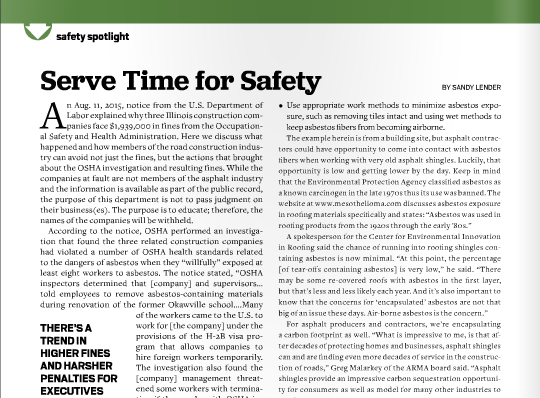Serve Time for Safety
BY Sandy Lender

An Aug. 11, 2015, notice from the U.S. Department of Labor explained why three Illinois construction companies face $1,939,000 in fines from the Occupational Safety and Health Administration. Here we discuss what happened and how members of the road construction industry can avoid not just the fines, but the actions that brought about the OSHA investigation and resulting fines. While the companies at fault are not members of the asphalt industry and the information is available as part of the public record, the purpose of this department is not to pass judgment on their business(es). The purpose is to educate; therefore, the names of the companies will be withheld.
According to the notice, OSHA performed an investigation that found the three related construction companies had violated a number of OSHA health standards related to the dangers of asbestos when they “willfully” exposed at least eight workers to asbestos. The notice stated, “OSHA inspectors determined that [company] and supervisors…told employees to remove asbestos-containing materials during renovation of the former Okawville school….Many of the workers came to the U.S. to work for [the company] under the provisions of the H-2B visa program that allows companies to hire foreign workers temporarily. The investigation also found the [company] management threatened some workers with termination if they spoke with OSHA inspectors.”
The day prior to the notice, OSHA cited two of the three companies for 16 egregious, nine willful and six serious violations, according to USDOL. “OSHA inspectors also found that [the companies] failed to warn employees, some of whom spoke only Spanish, of the danger—even though they were aware of the asbestos hazard. They also failed to ensure that workers used appropriate work methods and respirators, and to train them about the hazards of working around asbestos.”
The notice stated that OSHA also cited the third company for one serious and two willful violations. “The willful violations were for not training the workers or informing them about the presence of asbestos-containing material. The serious violation was for failing to conduct inspections as required by law.”
In its citations, OSHA has specific allegations against the companies that any employer can learn from. Here they are.
- Provide basic personal protective equipment such as hard hats, eyewear and protective clothing.
- Create a decontamination area for employees to remove work clothing before leaving the worksite.
- Use appropriate work methods to minimize asbestos exposure, such as removing tiles intact and using wet methods to keep asbestos fibers from becoming airborne.
The example herein is from a building site, but asphalt contractors could have opportunity to come into contact with asbestos fibers when working with very old asphalt shingles. Luckily, that opportunity is low and getting lower by the day. Keep in mind that the Environmental Protection Agency classified asbestos as a known carcinogen in the late 1970s thus its use was banned. The website at www.mesothelioma.com discusses asbestos exposure in roofing materials specifically and states: “Asbestos was used in roofing products from the 1920s through the early ’80s.”
A spokesperson for the Center for Environmental Innovation in Roofing said the chance of running into roofing shingles containing asbestos is now minimal. “At this point, the percentage [of tear-offs containing asbestos] is very low,” he said. “There may be some re-covered roofs with asbestos in the first layer, but that’s less and less likely each year. And it’s also important to know that the concerns for ‘encapsulated’ asbestos are not that big of an issue these days. Air-borne asbestos is the concern.”
For asphalt producers and contractors, we’re encapsulating a carbon footprint as well. “What is impressive to me, is that after decades of protecting homes and businesses, asphalt shingles can and are finding even more decades of service in the construction of roads,” Greg Malarkey of the ARMA board said. “Asphalt shingles provide an impressive carbon sequestration opportunity for consumers as well as model for many other industries to emulate.”
Even with a positive level of environmental sustainability, it’s up to the employer to ensure employees remain informed and safe at all jobsites. The editors at ConstructionDive.com pointed to a growing trend in harsher penalties for executives who deal recklessly with worker safety. For example, the State of California Department of Industrial Relations released a statement Aug. 3 with the results of the Cal/OSHA criminal investigation into the January 2012 death of a day laborer who had been buried alive in concrete. Santa Clara County Superior Court Judge William J. Monahan sentenced a company owner and a project manager to two years in prison for involuntary manslaughter. They received a prison sentence for a number of reasons, including, “When preventable deaths occur on the job, employers must be held accountable,” Cal/OSHA Chief Juliann Sum said. “Cal/OSHA worked closely with the Santa Clara District Attorney to ensure that criminal behavior in the workplace is addressed.”
Under the Occupational Safety and Health Act of 1970, employers are responsible for providing safe and healthful workplaces for their employees. OSHA’s role is to ensure these conditions for America’s working men and women by setting and enforcing standards, and providing training, education and assistance. For more information, visit http://www.osha.gov.
